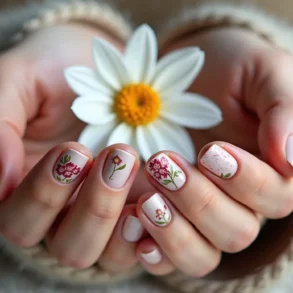The setting of nail polish, acetone-free remover and a cuticle pusher may not be one typically associated with environmental science and knowledge production. And yet it’s here, over manicures and nail clippings, that a deep understanding of a changing climate is articulated precisely, grounded in generations of lived experience.
Last September, on Truth and Reconciliation Day, residents of Tuktoyaktuk, NWT, gathered at the local community centre for an evening of self care, including nail art. Conversations flowed in many directions, including toward the environment. One participant, Blair Nuyaviak, used stickers and adhesive rhinestones to carefully craft jellyfish designs on her nails. While she worked, she described how jellyfish are increasingly seen floating near the shores in Tuktoyaktuk. As the ocean warms and currents alter, the sea ice breaks up earlier and forms later, which leads more jellyfish to find their way here. The increased presence of jellyfish, Blair noted, has in turn led to a decrease of other fish and marine mammals. Between layers of clear gel-paint the conversation moved to other climate-related issues such as the eroding shoreline and relocation plans facing community members of Tuktoyaktuk.
For Eriel Lugt, an Inuvialuk youth born and raised in Tuktoyaktuk, nail art is an important living practice in her community. When she travelled to Coast Salish Territories last October for the Inuit youth climate action summit, her nails were immaculately painted. Many Tuktoyaktukmiut love to do their nails, particularly during the long winters. It’s an intimate practice that brings people together in one another’s homes to chat, often over food, and talk about their days. In the wake of a recent suicide epidemic in Tuktoyaktuk, community members organised a series of wellness events focused on nail art as a way to check in on and take care of one another.
But nail design is not simply a cosmetic practice or social pastime — it’s also political.
Inuvialuit youth embracing creative methods of climate testimony
Western science models have long dominated the exploration of Arctic environments. The early 19th century saw various colonial expeditions aimed at extracting scientific data from northern regions to map and seek imperial expansion and prestige. These models often depend on laboratories and experts located far away in southern geographies to process and translate Inuit Nunaat, the lands of the Inuit.
A new Inuit co-led project joins a growing effort to resist extractive approaches that rely on foreign expertise and ways of knowing. Instead, “Carving out Climate Testimony: Inuit Youth, Wellness & Environmental Stewardship” supports young Inuvialuit leaders in their desire to enhance wellness and environmental stewardship in their own community of Tuktoyaktuk, where the effects of climate change are particularly acute.
As the Arctic warms up to four times faster than the global average, the residents of Tuktoyaktuk face an uncertain future. Tuktoyaktuk, like many Inuit homelands, is built on permafrost. Permafrost is harder than concrete, but rapid thawing has led to dramatic erosion.
Dwayne Drescher/Atdjaliak, an Inuvialuk member of the project team, notes, “My mother’s house is right on the coast of the harbour, and now there’s a big hole under the balcony. When I was a kid, I could walk all the way around the house. It’s getting to the point where the balcony is falling off the house completely. It’s pretty dramatic. It’s sad, too, because that’s where my dad chose to live.” Tuktoyaktuk is one of the first communities in what is recently known as Canada to face relocation.
Our research team, which comprises Inuit artists, activists, community members and academics from Canada to the UK, aims to understand how a changing climate is understood by Inuvialuit youth — on their own creative terms.
Following the work of Inuit Tapiriit Kanatami, the organization representing Inuit in Canada, and its vital National Inuit Strategy of Research, our project centres Inuit self-determination and Inuit Qaujimajatuqangit (Inuit knowledge). The project established an Inuit youth advisory who are responsible for developing the project’s key questions and agendas. As a member of the advisory, Lugt helped to design a communication strategy, determining which stories get told and — just as importantly — which ones do not. This strategy identifies risks associated with sharing certain personal stories, which may inadvertently cause harm to the community, and alternatively, the ways other stories can amplify important struggles.
The key question our project asks is: how can unikkausivut (embodied and artful forms of Inuit storytelling) articulate Inuvialuit concerns about changing social and physical environments in Tuktoyaktuk? And how are various forms of storytelling — from carving, to film, to murals — playing a role in identifying how climate change shapes daily life and a sense of the future? One surprising answer to this question: nail art.
Participants use nail art to document profound changes in environment
Nail art connects with a deeply held tradition of Inuit hand art, such as tattooing. Brian Kowikchuk, creative lead for “Carving out Climate Testimony,” led a workshop at the local Mangilaluk School last September, where hands also featured prominently. In the art produced, hands represented both connection and resurgence. Nail art is a natural extension of these traditional artful processes that emphasise hands as a canvas of connection and creativity.
Last Truth and Reconciliation Day, we organized the pop-up nail bar to further explore and experiment with nail art as a form of storytelling.
This nail bar included various stickers and decals with Arctic iconography, such as polar bears, ice and snowflakes. There was also pink and purple gel polish, a lamp to cure the gel polish and templates for participants to map out their nail stories.
As Blair Nuyaviak painted her jellyfish, another participant crafted a design inspired by the flowers she gathered on the tundra. A third juxtaposed images of fire and snow, reflective of the wildfires that have advanced farther north in recent summers.
As part of the “Carving out Climate Testimony” project, Inuvialuit youth travelled in March to Coast Salish Territories (Victoria, BC) to share observations about what they’re seeing and experiencing in Tuktoyaktuk with Canada’s leading climate scientists. Their testimony and artwork will be shared in Environment Canada’s Changing Climate Report 2025. Kowikchuk emphasized that the transformation is profound. “Aside from things that are being taken away by climate change, there are also things that are coming,” he says. “Like salmon. Aside from language and culture, our diet is going to change.”
Moving forward, our research team is exploring possibilities for exhibiting nail art both in Tuktoyaktuk and beyond. Finding ways to communicate climate change is important work. And we’re excited how nails can be used for community care and to beautifully share our stories about our changing environments.
This post was originally published on this site be sure to check out more of their content.




